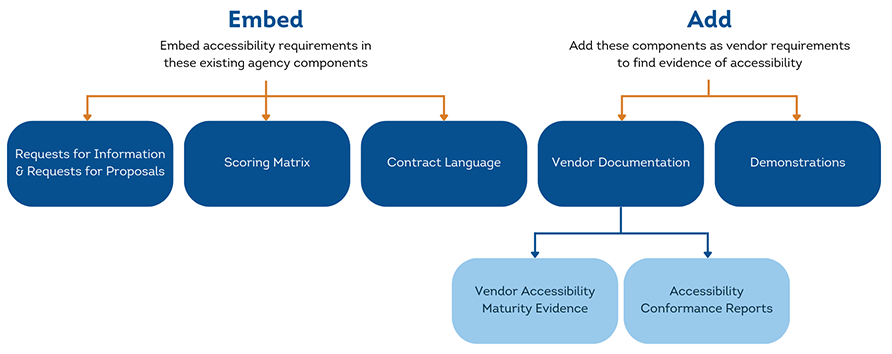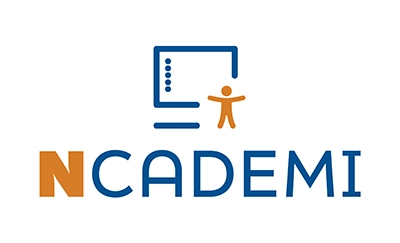Including Accessibility in All Components of Procurement: A Guide for State Educational Agencies and School Districts
Publication Date: April 2025
Download PDF – Procurement Guidance
Purpose and Intended Audience
Students with sensory, physical, and learning disabilities are at risk of falling behind in educational progress when the learning materials provided in schools are not accessible to them. To ensure access to the general education curriculum for students with disabilities, state and local education agencies can take specific actions when reviewing instructional material and adopting tech products. This guide informs all participants of state and local procurement teams about accessibility requirements/considerations in all phases and activities related to purchasing digital educational materials and technology. Representatives from general education, special education, and technology, as well as other staff in state and local education agencies, will find this information important to their roles and responsibilities.
Introduction
Ensuring all students with disabilities can use the digital materials and technology provided in the general education curriculum begins with procurement practices that include considerations of accessibility. Whether a learning material, app, or technology is developed, selected, or purchased as a product or subscription for use in a classroom, accessibility must be part of the process from the start. Keeping accessibility a priority ensures all students with disabilities have the opportunity to access the same information, engage in the same interactions, and otherwise participate in, or benefit from, the same services, programs, and activities as students without disabilities. Accessible technologies also provide substantially equivalent timeliness, privacy, independence, and ease of use for students with disabilities as cited in the Americans with Disabilities Act (ADA) Title II final rule, Nondiscrimination on the Basis of Disability; Accessibility of Web Information and Services of State and Local Government Entities.
Throughout the phases of procuring education materials or technology for widespread use at a state, district, or school level, education agencies must use new procurement tools and resources, or modify their existing tools and resources, to include accessibility considerations in the procurement process, as outlined in Figure 1 and described throughout this resource. At a minimum, new materials or technology must conform to the Web Content Accessibility Guidelines (WCAG) Version 2.1 at the Level AA success criteria or higher to meet the requirements of Title II of the ADA (See the NCADEMI ADA Title II Roadmap for State and Local Educational Agencies).
Though it is the responsibility of the state or local education agency to ensure all materials or technology meet these technical requirements, a deep understanding of these requirements is not necessary as long as accessibility is integrated into the procurement process. From the original procurement request to demonstrations and the final contract language, procurement tools and processes should always include accessibility considerations. Accessibility-focused tools and resources are available to help ensure the accessibility of whatever materials or technology are procured. By integrating accessibility considerations into every aspect of the decision-making process, states and schools can follow the current legal requirements and can prioritize equal access for students with disabilities.
Figure 1
Integrate Accessibility in All Components of Procurement Diagram

Text Version of Figure 1:
- Embed – Embed accessibility requirements in these existing agency components
- Requests for Information & Requests for Proposals
- Scoring Matrix
- Contract Language
- Add – Add these components as vendor requirements to find evidence of accessibility
- Vendor Documentation
- Vendor Accessibility Maturity Evidence
- Accessibility Conformance Reports
- Demonstrations
- Vendor Documentation
General Procurement Tools and Resources
States, districts, and schools making large purchases most likely already have tools and resources they regularly use throughout the procurement process. Efforts to revise and intentionally include accessibility considerations and requirements into these established tools or resources creates a strong foundation for a procurement process minimizing the need for separate, or specialized, processes only focused on accessibility for a small subset of students. Procuring digital products with clear expectations on accessibility means all procured products meet accessibility requirements and all students can access their learning, “in a manner that provides substantially equivalent timeliness, privacy, independence, and ease of use.”
Request for Information and Request for Proposals
Before a purchase is made, education agencies may issue a Request for Information (RFI) or a Request for Proposal (RFP). These requests provide details about what the purchasing agency needs in a product or service. The RFP is more common and states specific requirements and expectations of a product and vendor, including required documentation. Introducing accessibility as one of the requirements in either an RFI or an RFP, including requiring documentation about the vendor’s accessibility practices and their specific product’s accessibility, is critical.
Scoring Matrix
Accessibility must carry equal weight with other considerations when an agency decides on a purchase. The use of an objective scoring matrix is recommended best practice for achieving such a purchase. At a minimum, scoring candidate products based on their available accessibility information helps to avoid a decision-maker pushing the purchase of a less accessible product, all other things being equal. If a formal scoring system is not already in place, consider creating something that will help make an objective and informed choice without adding too much additional effort. If there is already a formal scoring system, integrate accessibility into it as a new scoring category or adjust the existing scoring so accessibility is at the same level of importance as other requirements.
Contract
Once an education agency settles on a product for purchase, any contract, agreement, memorandum of understanding, or other similar document must include language holding the product vendor to account for the claims they make about accessibility. If a product does not live up to those claims, then the education agency must be prepared to take steps to ensure the product is updated to make it as accessible as claimed or to cancel the contract. Accessibility language in contracts should also protect the education agency from being charged any additional costs by the vendor to perform these updates. Contracts should include details on the steps the purchasing agency will take if the agency discovers an undisclosed accessibility barrier in the product they have purchased. These details include how the purchasing agency will report the issue, how the agency will establish a timeline for the vendor to complete the necessary updates, and who will communicate with the vendor throughout this process.
NIMAS & NIMAC in Contracts and Purchase Orders
In relation to contracts and purchase orders with publishers of textbooks and related core instructional materials (both print and digital), users of this guide are pointed to procurement requirements under the Individuals with Disabilities Education Act (IDEA). The National Instructional Materials Accessibility Standard (NIMAS) and the National Instructional Materials Access Center (NIMAC) are provisions of IDEA for states and school districts to provide accessible formats in a timely manner. See NIMAS & NIMAC: What SEAs and LEAs Need to Know.
Accessibility Vetting Tools and Resources
Including accessibility in the procurement process requires additional documentation and communication that may not yet exist at the state, district, or school level. These additional efforts, however, will ensure any agencies have the information they need to make informed decisions and understand the risks of any accessibility barriers that may exist in the products under consideration. The goal with the tools and resources used for vetting the accessibility of education products is to find evidence of accessibility standards and practices embedded within the product itself, as well as in its development and deployment cycles.
Vendor Accessibility Maturity Evidence
It is helpful to ask vendors how they ensure the product(s) they build and sell are accessible. Ask vendors for a specific contact for accessibility-related questions. Then, ask about internal training, processes, and tools the vendor uses to ensure their teams integrate accessibility into their work.
Accessibility Conformance Report
The most common tool used to vet products for accessibility is the Accessibility Conformance Report (ACR). A vendor provides this report based on the Voluntary Product Accessibility Template (VPAT®). A quality ACR will disclose conformance to WCAG standards one at a time. The ACR also reports whether a product supports, partially supports, or does not support each of the WCAG standards. Agencies should take the time to review the ACR in detail. Ensure the ACR is for the version of the product under consideration or is at least for the product’s same primary version number. (If you are considering purchasing version 2.3, an ACR for version 2.1 could still provide useful information. Ask the vendor what has changed between these minor versions.) If no version number is provided, make sure the ACR’s date is within one year of your purchase. If the ACR is out of date, ask the vendor when they expect an update.
While some products do fully support WCAG standards, this is rare. Be sure vendors add comments to each line of the conformance table in the ACR. This table details how a product supports a given standard. If the ACR says the product partially supports a standard, look for a comment explaining where it is not supported and a timeline for when it will. If the ACR says the product does not support an item, look for a comment stating when it will. If no comments are given, or they don’t reveal much, make notes on the ACR and ask the vendor to provide more details.
WebAIM has a more detailed guide to vetting ACR documentation that expands on these points.
Demonstrations
Ask vendors to meet with your team for an hour for an accessibility-specific product demonstration. General product demonstrations may not be long enough to include demonstrating accessibility supports. A demonstration more focused on accessibility provides opportunities to ask vendors to show, for example, how their product supports keyboard-only navigation and interaction. An accessibility demonstration is also an opportunity to ask vendors to run a tool like WAVE over their product and examine the results.
Direct Testing
Direct testing is another common way to evaluate how accessible a product is. This tends to be the most time-consuming approach, especially with highly interactive web-based software. Ideally, properly vetting the product with a demonstration and ACR will reduce or eliminate the need for direct testing. Some product categories are small though, and direct testing may be the only way to gather this accessibility information. When performing direct testing, it may not be necessary to perform a full, manual, accessibility evaluation. Carefully selecting a representative sample of web pages and performing a scaled-back, but effective, set of tests can result in an adequately informed decision.
Summary
States and school districts must include accessibility in their procurement procedures to ensure students with disabilities gain equal access to the general education curriculum. Education agencies can start by adding accessibility requirements to their existing tools and resources, such as RFIs/RFPs, scoring matrices, and contracts. Vetting tools and resources can be developed to verify accessibility information provided by vendors and to hold vendors accountable for accessibility throughout the time period of the contractual relationship.
Recommended Citation
National Center on Accessible Digital Educational Materials & Instruction and National Instructional Materials Access Center. (2025, April). Including Accessibility in All Components of Procurement: A Guide for State Educational Agencies and School Districts. Logan, UT: Author. Retrieved [insert date] from https://ncademi.org/resources/publications/procurement/
